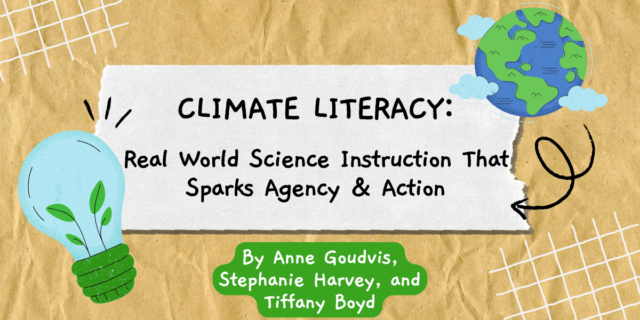
As educators, we strive to create a classroom community that is inclusive and supportive, and to provide all students the instruction they need to build confidence and thrive. The Comprehension Toolkit (Primary and Intermediate) supports teachers to teach content knowledge and thinking strategies to students who come from varying cultural and linguistic backgrounds and are learning English as a new language.
There is sometimes a misconception that students must first learn English, and only then can they read to learn content knowledge. Teaching with The Comprehension Toolkit offers these students ways to use comprehension and thinking strategies to build their background knowledge and confidently use thinking and learning strategies even as they learn a new language. Providing a classroom environment that is welcoming and honors students’ language, ideas, and experiences is the first step in ensuring their success.
The Comprehension Toolkit to support English Learners (ELs)
While the very same rich, meaning-based opportunities to learn should be offered to all students, a few additional practices offer English Learners (ELs) needed support. One of the resources developed to support The Comprehension Toolkit is an extensive guide to support ELs. Scaffolding for English Language Learners is available for both the Primary and the Intermediate Comprehension Toolkit. In addition, the small-group, targeted lessons in Comprehension Intervention offer extra support. Explore each of these resources:
- Scaffolding The Comprehension Toolkit for English Language Learners
- Scaffolding The Primary Comprehension Toolkit for English Language Learners
- Comprehension Intervention: Small-Group Lessons for The Comprehension Toolkit
- Comprehension Intervention: Small-Group Lessons for The Primary Comprehension Toolkit
Ultimately, nonfiction is the perfect medium for teaching reading, thinking, and learning strategies for all students, but it is especially well-suited for engaging ELs and supporting their learning a new language.
About The Comprehension Toolkit
Adapting and differentiating instruction is a hallmark of teaching comprehension with the Toolkits, which:
- Offers concrete, visual, and explicit examples. When introducing vocabulary and ideas, provide context, the more visual the better. Make thinking visible by creating charts with photos and images that make the content more comprehensible.
- Uses language as a tool to anchor big ideas, vocabulary, and concepts. As we teach Toolkit lessons, we create anchor charts that help kids remember content, as well as a consistent strategy language for talking about their thinking and learning. Anchor charts are tools that continue to scaffold instruction for small-group and the whole-class learning across all of our literacy and content area units.
- Uses descriptive language and images that kids can easily access to support oral language and talk. Having kids talk about what they are thinking and learning is an effective way to reinforce learning in a new language.
- Links the new to the known. Spend time building and accessing background knowledge in whatever language kids are comfortable with—and make explicit connections. Language cognates and visuals make these connections more understandable.
- Encourages kids to “have a go” at expressing their thoughts and questions even if they are a little unsure of what to say or how to say it. Include additional time for student talk in large and small groups. ELs are often more confident when trying out their new language in pairs or small groups.
- Encourages lots of conversation as this is the best window into student understanding. Make sure that students are comfortable asking questions when they are confused or understanding eludes them. Offer opportunities for students to teach others about themselves, their background knowledge, and their new learning.
- Teaches a common language for learning. For students learning a new language, having a clear, consistent language that describes thinking and learning routines is essential.
- Prioritizes collaboration. We believe it is essential to create one instructional plan that is responsive to the learning and language needs of all the kids in the school (Commins and Miramontes 2005). This requires that teachers make a deliberate and sustained effort to collaborate. If ELs have support teachers, plan to work together to develop instruction.
The goal of Toolkit resources for students learning English is to make learning in a new language accessible, comprehensible, and engaging. Biliteracy, the ability to effectively communicate and understand written ideas in two different languages, is a goal in many schools, and to our way of thinking, it’s so important that children speaking two languages (or more!) continue learning and developing their language proficiency in both. We created The Comprehension Toolkit lesson frames in Spanish so that teachers have a Toolkit resource at their fingertips for teaching in Spanish. In addition to the lesson frames, there are many short nonfiction texts in English and Spanish available in the Toolkit. Check out the Spanish versions of articles in our Source Book of Short Text, as well as Toolkit Texts at varying grade levels.
Download two free lessons from The Comprehension Toolkit: “Merge Thinking with New Learning” (from the Primary Toolkit) and “Merge Your Thinking with New Learning” (from the Intermediate Toolkit).
Learn more about The Comprehension Toolkit at ComprehensionToolkit.com.

Steph Harvey and Anne Goudvis are the coauthors of Strategies That Work, Inquiry Illuminated, The Comprehension Toolkit Series and Short Nonfiction for American History. Teachers first and foremost, they work in classrooms side by side with kids supporting teachers in progressive literacy practices.


